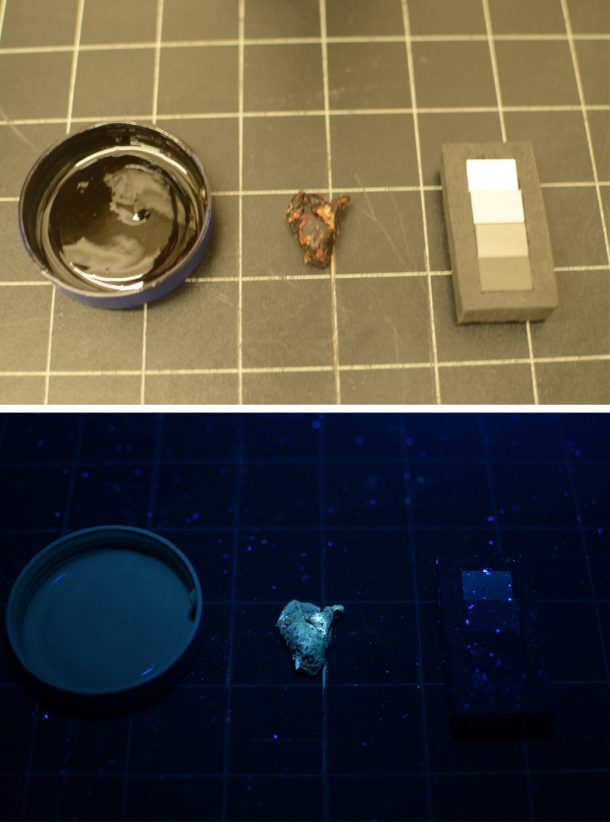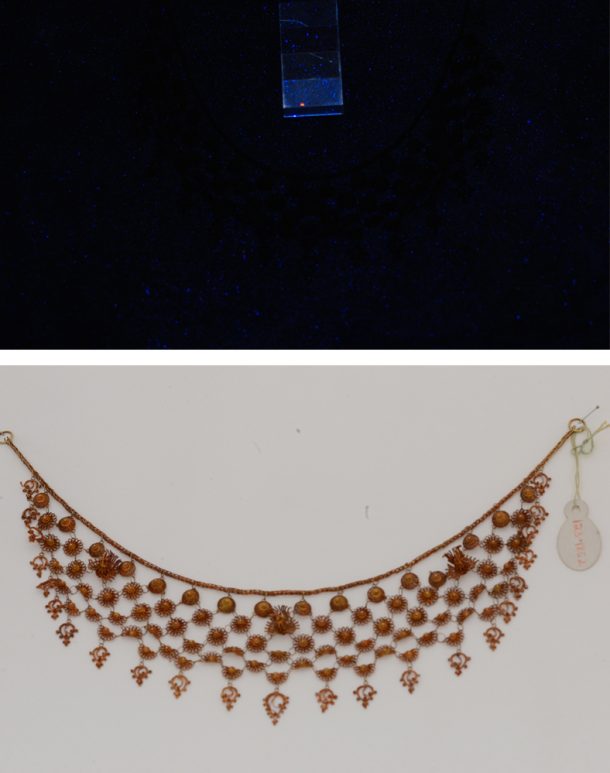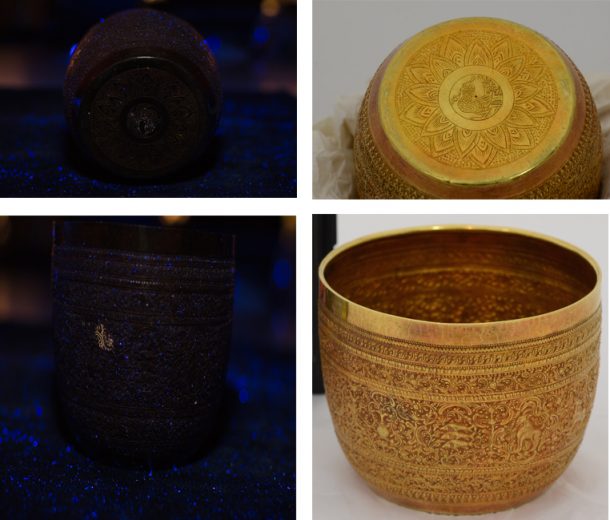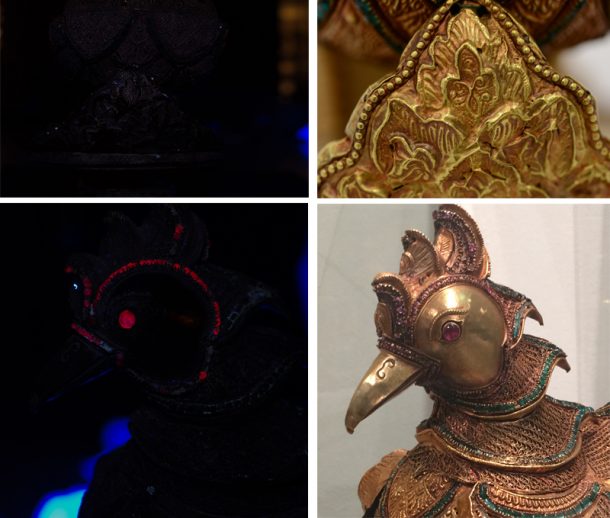by Emma Burdon, MA Student, Courtauld Institute of Art
In the collection of the Victoria and Albert Museum, there are eleven gold objects that are described as being coloured red using tamarind. They originate from Burma (Myanmar) and Thailand, and are thought to have been made during the nineteenth century. The Burmese objects are as follows: five necklaces (123-1852, 03160(IS), 0316(IS), IM.38-1927, IM.39-1927); a bowl (02747(IS)); an ear-cylinder (03172(IS); and a hintha-shaped betel box and stand (IS.246&A-1964). From Thailand, there are two boxes (IM.49-1937, IM.50-1937), and a stand (IM.55-1937). The objects from Thailand and the ear cylinder have been identified as ‘stained with tamarind juice’. Others, principally from Burma, are identified as coloured red by ‘boiling the gold with tamarind seeds or exposing it to the fumes of burning sulphur during the smelting process’. Tamarind was chosen for investigation because all of the objects in the study are thought to have been coloured using tamarind in some way. Whether tamarind juice was used to ‘dye’ gold was the subject of a preliminary investigation undertaken as a dissertation for an MA in Buddhist Art: History and Conservation at the Courtauld Institute of Art in collaboration with the V&A.
The use of tamarind can be traced to textual sources. Wardle (1886) writes that the red colour on Thai vessels is achieved by using tamarind juice as a dye1. Thompson (1910) reported that Siamese royal vessels were sometimes ‘stained crimson with tamarind dye’2. Scott (1906) notes that gold objects were boiled with tamarind seeds to create a red hue, while Bird (1897) writes that exposing the metal the fumes of burning sulphur during the smelting process will have a similar effect. Scott and Bird are cited by Fraser-Lu (1994), who writes that the ‘muted reddish hue’ favoured by the Burmese ‘was obtained either by boiling the metal with tamarind seeds, or by exposing it to the fumes of burning sulphur during the smelting process’3.
A motivation behind this research was to understand how the materials would behave, and therefore how the objects should be cared for. The presence of an organic colorant, for example, may restrict light levels for its long-term preservation. In order to better understand the materials and techniques involved in producing red-dyed gold, different non-invasive tests were carried out. For this preliminary study, it was not possible to replicate the various recipes for the production of red gold. One of the main limitations of this research is that it only refers to fresh tamarind paste, which is just one possible option for the fabrication of red gold objects.
Visual analysis was carried out as an initial examination, in order to determine the nature of the dye and how it may have been applied. No brush marks were observed, suggesting that the layer was not painted on. The colour appeared on both the inside and the outside of the vessels, indicating that the objects may have been immersed in a substance to colour them. Macrophotography and microscopy clearly showed that the red colour forms a coherent and superficial layer, which is not found within the main bulk of the gold, indicating the red hue was not obtained by alloying gold with copper.
Ultraviolet-induced luminescence imaging (UIL) was used to examine each object, to try and locate the presence of luminescent organic materials, such as tamarind. Fresh tamarind paste has a weak, blue-white luminescence, whereas the intact fruit has a white luminescence (Figure 1). Some objects, for example 123-1852 (Figure 2) showed no luminescence.


While there was some luminescence detected on a number of objects, it did not correspond to the red areas. For example, the Burmese bowl (02747(IS)) (Figure 3) shows some yellow luminescence properties in a small area on the base and on the side. As this area does not correspond to the red on the object, it cannot be associated with the red colour. There was an area of weak, yellow-white luminescence on the tail of IS.246A-1964 (Figure 4). However, even in this case, there was not a strong correlation between the red on the object and areas of luminescence. While none of the objects consistently produced similar luminescence, this does not disprove the presence of tamarind. Luminescence can be affected by the presence of other materials such as binders, and metals may have quenching properties. Additionally, aged tamarind may have different luminescent properties from fresh tamarind.


X-ray fluorescence spectroscopy (XRF) was used to characterise the composition of the metal. As XRF cannot detect the presence of hydrogen, carbon and oxygen, it is not a suitable technique to detect organic compounds, such as tamarind dye, so it was used alongside other methods of analysis. The XRF results corroborated the visual analysis that the red colour is not due to the presence of high quantities of copper.
Fourier Transform infrared spectroscopy (FTIR) was used to try to identify organic or inorganic compounds present. As there was no ‘Tamarind’ reference spectrum on the Infrared & Ramen users Group (IRUG) database of heritage materials, a reference was made using fresh TRS commercial tamarind paste. None of the samples from the objects matched the FTIR reference closely enough to confirm the presence of tamarind as a dye. FTIR did detect the likely presence of organic materials, as shown by CH-stretchings at around the 3000 cm-1 region on the readings taken, indicating the presence of hydrocarbons, particularly calcium oxalate (Whewellite/Weddelite), a product of organic degradation. However, none of the readings corresponded with the FTIR reference for tamarind captured for this study. Additionally, CH-stretchings alone cannot be easily used to identify organic materials. While there is an indication that some organic materials might be present, their origin could not be determined.
It is possible that tamarind was used, but in a more complex method than identifiable by the non-invasive methodology used here for its identification. In addition, tamarind may have undergone modifications during the dying of the gold and because of ageing. Other materials may also have been involved in its production. For example, Richter and Carpenter (2011) draw attention to a report devoted to metalwork in Indonesia by Jasper and Pirngadie (1927), which includes several methods for producing red gold4. Richter (2010), referring to Jasper and Pirngadie, outlines a process involving ‘repeated chemical cleaning, drying, very gentle heating, and then the submersion of the item in chemical compounds’. One compound is a mix of tamarind or rotted citrus fruit, combined with sulphur to make an acidic paste. The other is a combination of potassium nitrate, rock salt and alum.5
Although the results of this study were inconclusive, it is hoped that this preliminary research will provide a useful reference for further invasive investigations, such as scanning electron microscopy (SEM) and high performance liquid chromatography (HPLC), as well as experimental attempts to interpret and replicate the various historic recipes for a more systematic approach to reveal the ‘secrets’ of red-dyed gold.
Acknowledgements:
I would like to thank Diana Heath for introducing me to red-dyed gold at the Victoria and Albert Museum. I am also grateful to Dr Giovanni Verri, Dr John Clarke, Anne Bancroft, Catriona Gourlay and Anita Nathwani for their help and guidance in carrying out this research.
References
- Wardle, T., Colonial and Indian Exhibition, 1886, Empire of India-special catalogue of exhibits by the Government of India and private exhibitors. W. Clowes, London, 1886, p.268
- Thompson, P. A., Siam: an Account of the Country and the People, J. B Millet, Boston, 1910, p.146
- Fraser-Lu, S., Burmese Crafts, Past and Present. Oxford University Press, Oxford, 1994, p.170
- Richter, A. and Carpenter, B., Gold Jewellery of the Indonesian Archipelago, Editions Didier Millet, Singapore, 2011, p.8
- Richter, A., The Jewellery of Southeast Asia. 2nd Edition, Rorimer. London, 2010, p.158



I read your entire article and I genuinely like it.